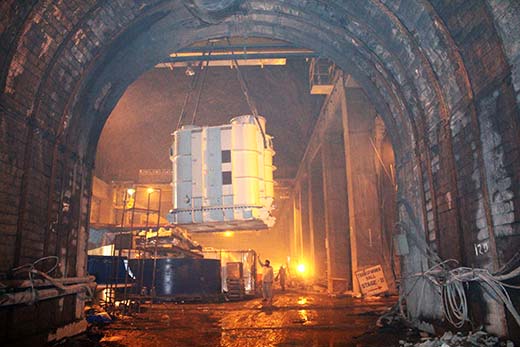At a time when the return of two NHPC-owned power projects is being debated at the highest level, water-abundant, energy-deficit J&K is offering a contrasting picture of the two mega projects. While the company implementing the Ratle project has literally abandoned the scheme, Baglihar-II is still on track, reports R S Gull
 It has been weeks now that the Hyderabad-based GVK Development Projects Private Limited (GVK) has fled from Chenab Valley. Implementing the state’s biggest power project with 850 MW installed capacity, the project was termed as a game-changer because it was allotted based on the tariffs that developers offered.
It has been weeks now that the Hyderabad-based GVK Development Projects Private Limited (GVK) has fled from Chenab Valley. Implementing the state’s biggest power project with 850 MW installed capacity, the project was termed as a game-changer because it was allotted based on the tariffs that developers offered.
“We are in the process of getting them back to work,” a senior J&K Power Development Corporation (PDC) executive said. “We have had at least one meeting with them and they are also keen to resume work.”
It has been an interesting case. The company has already spent nearly Rs 600 crore on the project in the last few years, halted its operations abruptly and then left the scene. The company told PDC that the government was not supportive of implementing the project and had ignored frequent pleas that the local population was creating their problems. So when the GVK management had a meeting recently, they came up with a series of pre-conditions for the resumption of the work.
Apart from the early acquisition of the land and a high-level empowered committee to look after the day-to-day affairs, GVK is seeking enhanced protection of its personnel and improved local support. “They are referring to various instances in which they allege that the locals seeking employment attacked their offices and personnel,” one PDC official said. “But the problem is there has not been any FIR with the police that would corroborate the accusation.” This is, despite the fact, that there were instances of local pressures for more than one reason.
Certain pre-conditions that GVK management put forward may require decision-making at the highest level which is not possible given the governor’s rule. GVK is seeking a waiver of Water Usage Charges saying the law was promulgated after they had bagged the project! It also wants the exemption of taxes on the import of machinery. Besides, the company wants compensation for any delay that discussions under the Indus Water Treaty may result in.
Run of the river project, Ratle was initially expected to be 690 MWs but a subsequent survey by the GVK after bagging it for implementation led to its upgradtion to 850 MWs. J&K’s first project being implemented on a BOOT (built, operate own and transfer) basis, it will be returned to PDC after 35 years. Given for implementation through innovative tariff-based bidding, PDC will get 15% generation as royalty and will enjoy the first right to purchase for 55% generation at the rate of Rs 1.44, a unit. As per the agreement, the project must start commercial generation by December 2017.
“The company cannot afford to leave the project because it is bound by the agreement and it has invested heavily,” a PDC executive said. “But if it does, we can complete it.” Soon after the financial closure, GVK had inked deals with French equipment maker Alstom for electro-magnetic parts worth Rs 842 crore and with Larson and Turbo for the civil works. It built a couple of bridges as work on the diversion tunnel was at full pace when the work stopped. Insiders said the GVK’s real problem is that it is facing financial issues.
With 450-MW Baglihar, the game-changing project in hand and running successfully, PDC is confident of managing any project now. “Against the design energy of 2600 million units of year, we are generating more,” Abdul Wahid Lone, Chief Engineer Baglihar said. “We generated 2842 mus in 2012-13 and 2800 mus in 2013-14 and it is a huge money touching Rs 1000 crore a year.”
The project will see a quantum jump once the second phase takes off. Also of the same capacity, the second unit will cost PDC Rs 3110 crore. “If everything goes as per the script, the first of the three units must get into operation by May 2015, the second unit by July and the last unit by August end,” Lone said. “By September 2015, the commercial generation will start.” This will increase PDCs revenue from this project – now 900 MW strong, to Rs 1400 crore, a year.
Now the new thinking in PDC is that it is exploring possibilities of having Baglihar-III with almost the same capacity. PDC sources said they have done the basic pre-feasibility report (PFR) and would require a detailed project report (DPR) once the corporation’s board approves the idea.
“We intend to use the same dam for running the three units of the third phase,” one insider said. “But it will have restricted utility for 100 days a year.” This phase, if approved, can be set up on the left side of the dam as the two phases are on the right side of the dam.
Mighty Chenab, usually referred to as J&K’s powerhouse, flows with 2000 cumecs (one cumec is 35 cusecs) of discharge for around five months. It gradually goes down, and for around 100 days, its discharge touches a low of 100 cumecs. Generally, all the units (which will be six in two phases by the end of 2015) run at full capacity for slightly more than three months and only one unit for three months of winter. For six months, the number of operational units varies as per the availability of water – it usually is two units.















